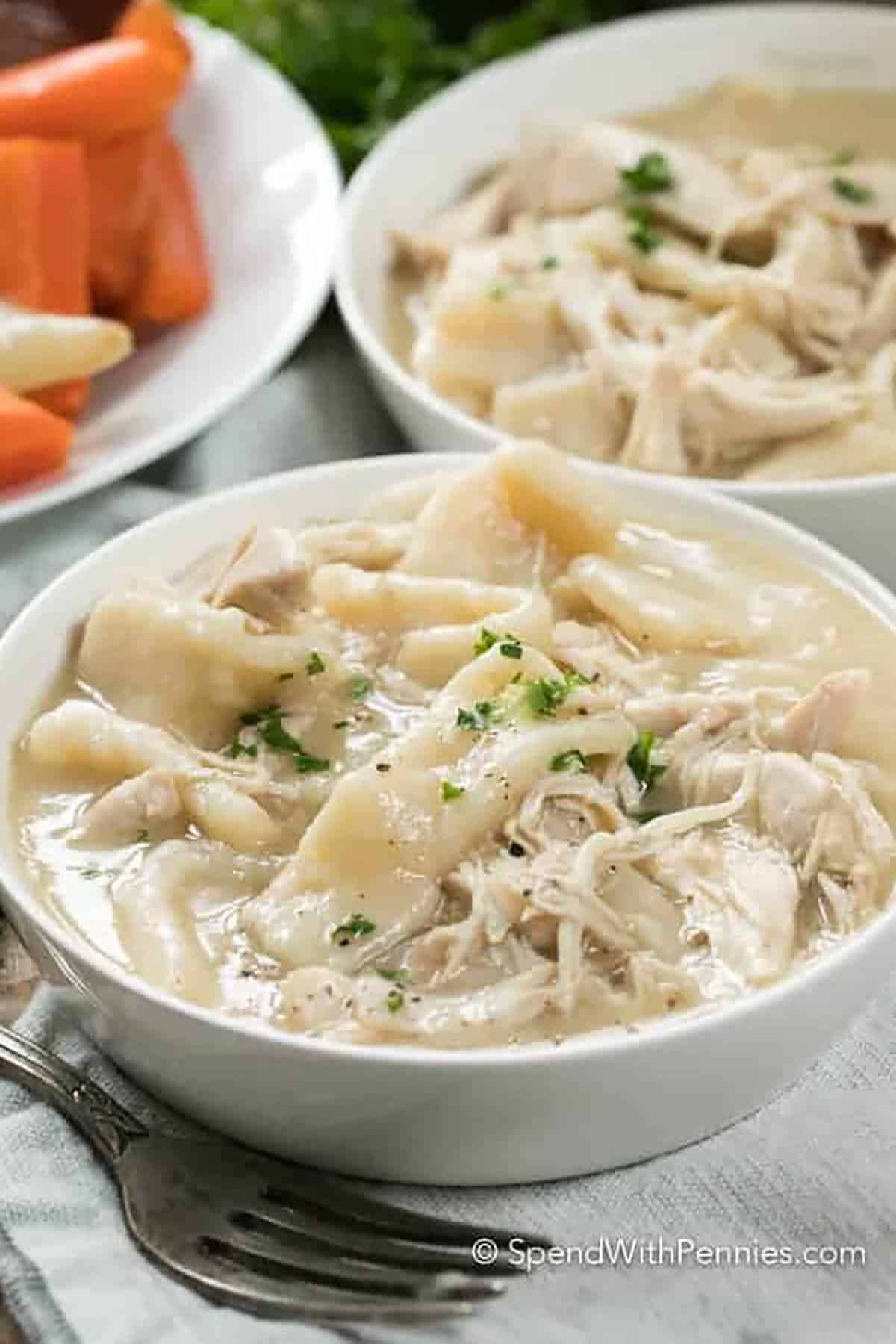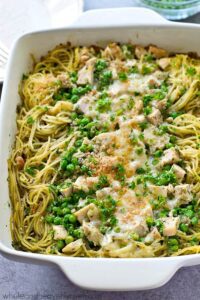Chicken and Dumplings a Comforting Classic is a delicious recipe that combines amazing flavors and textures.
Chicken and Dumplings represents the epitome of comfort food—a hearty, warming dish that soothes the soul and satisfies the appetite. This classic preparation features tender chicken in a rich, flavorful broth with vegetables, topped with light, fluffy dumplings that steam to perfection right on top of the stew. The combination of textures—the silky broth, the tender chicken, the softened vegetables, and the pillowy dumplings—creates a symphony of comfort in every spoonful.
What makes this dish special is its dual cooking method: the stew simmers to develop deep flavors, then the dumplings cook directly on top, absorbing some of the broth’s essence while maintaining their distinct texture. This creates a harmonious relationship between the components that can’t be achieved by cooking them separately. The dish exemplifies the principle of “whole greater than the sum of its parts”—simple ingredients transformed through patient cooking into something extraordinary.
The Science of Stew Making
Creating the perfect chicken stew involves understanding several chemical processes. The Maillard reaction occurs when browning the chicken, creating complex flavor compounds that form the foundation of the stew’s depth. Collagen in the chicken bones and skin converts to gelatin during simmering, providing body and mouthfeel to the broth. The vegetables release their natural sugars and starches, further enriching the liquid.
The dumplings rely on baking powder for leavening—when combined with liquid, it produces carbon dioxide bubbles that are trapped by the gluten network, causing the dumplings to rise. The steam cooking method ensures they remain light and fluffy rather than becoming dense or gummy. The lid must remain closed during cooking to maintain consistent temperature and moisture levels.
Ingredient Selection Guide
Chicken: Bone-in, skin-on chicken thighs are ideal for stews as they contain more collagen and fat than breasts, resulting in richer flavor and more tender meat. The bones contribute gelatin to the broth, creating better body. If using breasts, add them later in the cooking process to prevent drying out.
Broth: Use quality chicken broth rather than water for maximum flavor. Homemade broth is ideal, but if using store-bought, choose low-sodium versions to control salt levels. The broth should be rich enough to stand on its own since it won’t reduce significantly during the relatively short cooking time.

Vegetables: The classic mirepoix (onion, carrot, celery) forms the flavor base. Cut vegetables into uniform sizes for even cooking. For variation, consider adding peas, corn, or green beans during the last few minutes of cooking.
Dumpling Ingredients: Use fresh baking powder for maximum lift. Cold milk and melted (but not hot) butter help create tender dumplings. Handle the dough as little as possible to avoid developing too much gluten, which would make the dumplings tough.
Technique Mastery
Browning: Properly browning the chicken creates fond—the caramelized bits on the bottom of the pot—that forms the flavor foundation of the stew. Don’t crowd the pot, which would cause the chicken to steam rather than brown. Work in batches if necessary.
Simmering: Maintain a gentle simmer rather than a rolling boil once the chicken returns to the pot. Boiling can make the chicken tough and cause the vegetables to break down too much. The ideal temperature is around 180-190°F—bubbles should break the surface occasionally but not vigorously.
Shredding Chicken: Allow the chicken to cool slightly before handling. Use two forks to shred—one to hold the meat in place, the other to pull strands away. Alternatively, you can chop the meat if preferred.
Dumpling Formation: Use two spoons to drop dough onto the stew—one to scoop, the other to push the dough off. Work quickly to ensure all dumplings cook evenly. Space them slightly apart as they will expand during cooking.
Regional Variations
Southern Style: Often includes a roux for thicker broth and may use buttermilk in the dumplings for tanginess. Sometimes includes hard-boiled eggs in the stew—a tradition dating to times when chickens were kept for both meat and eggs.
Pennsylvania Dutch Style: Features thicker, noodle-like dumplings called “slippery dumplings” that are rolled and cut rather than dropped. The broth is typically clearer and less thickened.
Midwestern Style: Often includes additional vegetables like peas and corn. Sometimes uses baking powder biscuits instead of traditional dumplings for a different texture.
Modern Interpretations: Contemporary versions might include herbs like tarragon or dill, add mushrooms for umami depth, or incorporate spices like paprika or turmeric for color and flavor complexity.
Serving and Storage
Serve chicken and dumplings immediately after preparation while the dumplings are still light and fluffy. Ladle into shallow bowls to showcase the different components. A simple green salad or steamed green vegetables make excellent accompaniments to balance the richness.
Leftovers can be refrigerated for up to 3 days, though the dumplings will absorb more broth and become softer upon reheating. To reheat, place in a covered pot over low heat, adding a splash of broth or water to maintain moisture. The dish doesn’t freeze well as the dumplings become mushy when thawed.
Nutritional Considerations
For a lighter version, remove the chicken skin before cooking and use low-fat milk in the dumplings. You can increase the vegetable content and decrease the chicken quantity for a more plant-forward version. Using whole wheat flour in the dumplings adds fiber but will result in a denser texture.
Those watching sodium intake can use low-sodium broth and limit added salt, relying instead on herbs and aromatics for flavor. The dish is naturally gluten-free except for the dumplings—use a gluten-free flour blend with xanthan gum for gluten-free versions.
Historical and Cultural Context
Chicken and dumplings has roots in various culinary traditions. European immigrants brought dumpling-making techniques to America, where they were adapted to local ingredients. The dish became particularly popular during the Great Depression as a economical way to stretch expensive protein with inexpensive flour.
Different regions developed distinct styles based on available ingredients and cultural influences. The dish appears in countless community cookbooks and family recipe collections, often with personal variations that reflect family traditions and preferences.
Troubleshooting Common Issues
Broth too thin: Create a slurry with cornstarch and cold water, then stir into the simmering stew before adding dumplings. Alternatively, remove some of the cooked vegetables, puree, and return to the pot to naturally thicken.
Dumplings too dense: This usually results from overmixing the dough or using old baking powder. Mix until just combined—some lumps are fine. Test your baking powder by adding a pinch to hot water; it should bubble vigorously.
Dumplings not cooking through: Ensure the stew is at a steady simmer before adding dumplings, and keep the lid closed during cooking to maintain temperature. The dumplings should float when done—if they sink, cook for a few more minutes.
Final Thoughts
Chicken and Dumplings represents more than just a meal—it’s a culinary hug that comforts and satisfies on multiple levels. The process of slowly transforming simple ingredients into something greater exemplifies the magic of cooking. Whether following a family recipe or creating your own tradition, this dish offers both nourishment for the body and solace for the soul, connecting us to generations of cooks who have found comfort in its preparation and enjoyment.

Chicken and Dumplings a Comforting Classic
Ingredients
Method
- Season chicken thighs with salt and pepper.
- Heat olive oil in a large Dutch oven over medium-high heat.
- Brown chicken on both sides, about 5-6 minutes per side. Remove and set aside.
- Reduce heat to medium and add onion, carrots, and celery. Cook until softened, about 5 minutes.
- Add garlic and cook for 1 minute until fragrant.
- Pour in chicken broth, scraping up any browned bits from the bottom.
- Add thyme and bay leaf. Return chicken to pot.
- Bring to a simmer, then reduce heat to low, cover, and cook for 25 minutes.
- Remove chicken and let cool slightly. Discard skin and bones, shred meat.
- In a medium bowl, whisk together flour, baking powder, and salt.
- Add milk and melted butter, stirring until just combined. Do not overmix.
- Return shredded chicken to pot. Bring stew to a gentle simmer.
- Drop dumpling dough by tablespoonfuls onto the simmering stew.
- Cover and simmer for 15 minutes without lifting lid.
- Remove from heat, stir in heavy cream and parsley.
- If desired, thicken with cornstarch slurry. Season to taste and serve hot.



